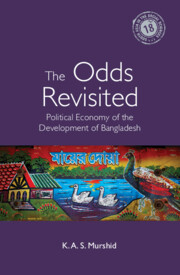Book contents
- Frontmatter
- Dedication
- Contents
- List of Tables and Figures
- Acknowledgements
- List of Abbreviations
- Introduction
- 1 A Bird’s-Eye View of the Bangladesh Economy: 1971–2020
- 2 Initial Conditions: The Odds Revisited
- 3 The Food Security Challenge
- 4 Exploring Transition and Change in the Rice Market
- 5 International Migration
- 6 The Rural Non-farm (RNF) Sector
- 7 Industrialization and the Rise of RMG
- 8 Industrialization: Other Stories
- 9 The Social Sector Puzzle
- 10 Dhaka: Capital Formation—Urbanization, Competition and the Rise of a Business Class
- Conclusion
- Notes
- Glossary
- References
- Index
7 - Industrialization and the Rise of RMG
Published online by Cambridge University Press: 30 June 2022
- Frontmatter
- Dedication
- Contents
- List of Tables and Figures
- Acknowledgements
- List of Abbreviations
- Introduction
- 1 A Bird’s-Eye View of the Bangladesh Economy: 1971–2020
- 2 Initial Conditions: The Odds Revisited
- 3 The Food Security Challenge
- 4 Exploring Transition and Change in the Rice Market
- 5 International Migration
- 6 The Rural Non-farm (RNF) Sector
- 7 Industrialization and the Rise of RMG
- 8 Industrialization: Other Stories
- 9 The Social Sector Puzzle
- 10 Dhaka: Capital Formation—Urbanization, Competition and the Rise of a Business Class
- Conclusion
- Notes
- Glossary
- References
- Index
Summary
The story is well known. Historically, Bangladesh exports were dominated by just one cash crop, namely jute, which accounted for nearly 90 per cent of total exports. Jute prices, however, experienced considerable volatility around a long-term secular decline in its terms of trade, imparting a high degree of uncertainty to export earnings. Remittance earnings opened up a much-needed additional source of foreign exchange, serving to lessen dependence on jute.
At the same time that remittances were beginning to flow in, in the late 1970s, crucial first steps were also being taken that would ultimately lead to the emergence of the apparels or RMG sector. Both remittances and RMG exports signalled a more open and accessible world market where poor, labour-abundant countries could find a niche on the basis of their comparative advantage. The global climate was more favourable for poor countries like Bangladesh, either by design or as the accidental consequence of advanced countries pursuing their own self interests. Thus, once the RMG potential was demonstrated, the response from local entrepreneurs was lightning-fast. The government, it must be underlined, rose quickly to take advantage of the opportunity to introduce incentives and policies to move things forward quickly for the RMG sector. Key initial movers who were close to the corridors of power played a crucial role in bringing the government fully on board. One could also argue that the government in the 1980s initiated a distinct change in its stance on ‘socialism’, which had earlier led to policy ambivalence and moved towards a more supportive role for private sector-led, capitalist development.
The Stylized Facts
The mid-1970s saw certain important changes in the world market for RMG. Advanced (importing) countries were getting increasingly worried about being swamped with low-cost clothes from East Asia, and as a precautionary move enacted the Multi-fibre Arrangement (MFA) in 1974, replacing the earlier Agreement on International Trade in Cotton and Textiles, 1964, under which country-specific quotas were imposed on major exporting developing countries.
The move was driven essentially by protectionist motives on the part of importers (the US and EU mainly) who were concerned about the effects on their own manufacturing industries.
- Type
- Chapter
- Information
- The Odds RevisitedPolitical Economy of the Development of Bangladesh, pp. 99 - 113Publisher: Cambridge University PressPrint publication year: 2022



